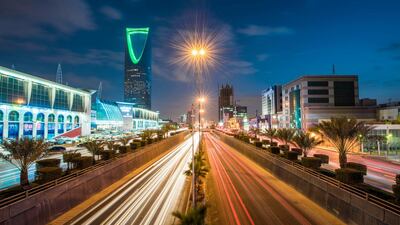S&P Global Ratings affirmed Saudi Arabia’s "A-/A-2" sovereign credit rating on prospects of a robust economic recovery aided by its strong net asset position and higher crude prices.
The credit rating agency said on Saturday that it expects the Saudi government's net asset position to remain sufficiently strong over the next two years to support the stable outlook.
The kingdom has sizeable fiscal and external net asset buffers that were built up during years of high oil prices.
Saudi Arabia's real gross domestic product contracted as oil prices fell amid the coronavirus-induced global recession.
However, its economy made a strong recovery in the fourth quarter as it grew by 2.5 per cent, according to official data.
The global economic recovery after Covid-19, higher oil prices caused by rising demand and a wider availability of vaccines worldwide will support the kingdom’s real GDP growth, which was forecast at about 2.3 per cent between 2021 and 2024, S&P said.
The fiscal deficit, which widened to 11.2 per cent of GDP in 2020, is expected to fall steeply to 5 per cent in 2021, before rising to about 6.3 per cent between 2021 and 2024.
Saudi Arabia’s budget deficit is financed by a combination of external and domestic debt and drawdowns from its existing stock of assets.
“We expect reserves to cover an average of 17 months of current account payments in 2021 to 2024 as the country maintains a strong net external asset position,” S&P said.
It said Saudi Arabia’s current account would return to surplus because of improving global macroeconomic conditions and oil prices as the world begins to emerge from the pandemic.
The current account balance of the Arab world's biggest economy had a deficit of 2.3 per cent of GDP in 2020, compared with a surplus of 6 per cent in 2019.
In 2021, the credit rating agency expects the current account to revert to a surplus of 4.8 per cent and about 3.8 per cent of GDP between 2021 and 2024.
The Opec+ group, led by Saudi Arabia and Russia, has kept a tight lid on output and has been drawing back 7.2 million barrels per day since the year began. The current curbs are set to end in April.
Saudi Arabia, the world's largest oil exporter, is also contributing an outsize cut of 1 million bpd until the end of next month.
These Opec+ measures and growing demand as the global economy emerges from the pandemic have caused the price of Brent to rise.
Higher oil prices will be partially counterbalanced by Saudi Arabia's lower oil production volumes in 2021.
However, crude and exports such as plastics and petrochemicals are expected to benefit from a rebound in global demand, especially from China and the US, according to S&P.
“Saudi Arabia is the only country in the world that maintains large excess oil export capacity and is therefore able to ramp up production by around 2 million bpd within days,” said S&P.
“Alongside its large production capacity and its leadership role in the global Opec and oil markets, this provides it with some supply-side pricing power and fiscal flexibility that is not available to other oil producers. This can at times help its fiscal and growth strategies.”
The pandemic weighed on both Saudi Arabia's oil economy, which contributes about 40 per cent of the country's GDP, and the non-oil economy in 2020.
Non-oil revenue accounted for about half of Saudi Arabia’s total revenue in 2020.
S&P said revenue in 2021 would be supported by higher oil prices, the full-year benefit of a VAT increase and an expected $75bn dividend from state-owned oil company Saudi Aramco.


